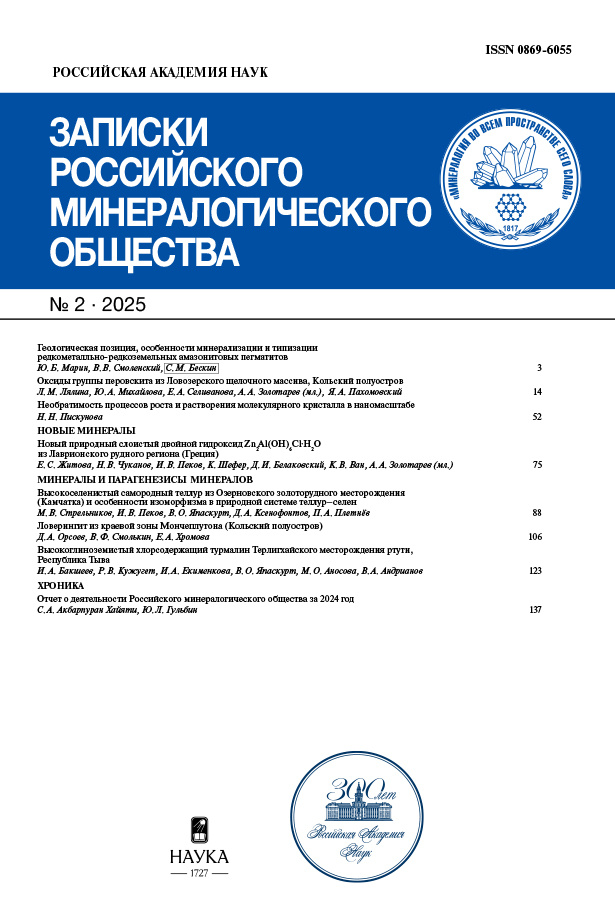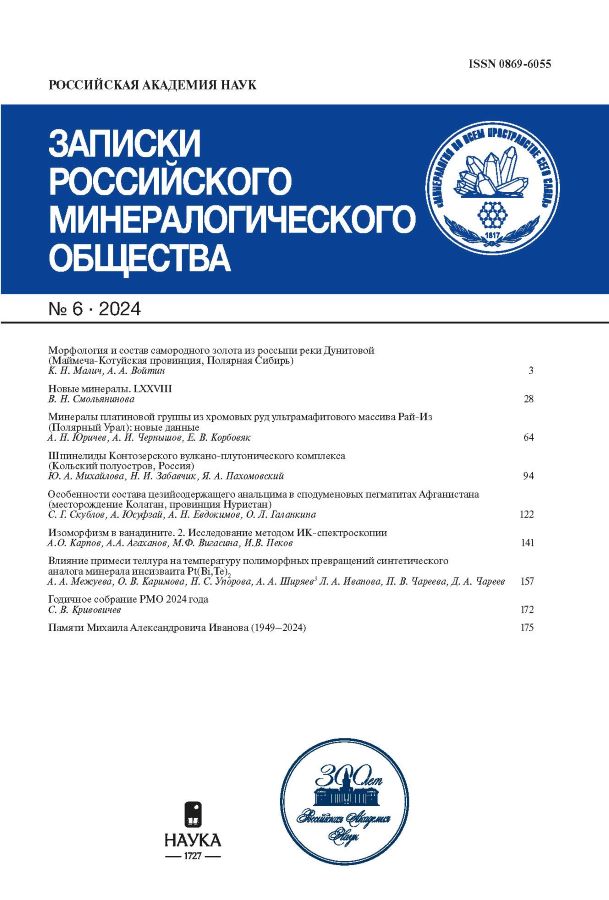Morphology and composition of gold minerals from the placer deposit of Dunitovaya River (Maimecha-Kotui Province, Polar Siberia)
- Authors: Malitch K.N.1, Voitin A.A.1
-
Affiliations:
- Zavaritsky Institute of Geology and Geochemistry, Ural Branch RAS
- Issue: Vol CLIII, No 6 (2024)
- Pages: 3-27
- Section: Articles
- URL: https://bakhtiniada.ru/0869-6055/article/view/287024
- DOI: https://doi.org/10.31857/S0869605524060017
- EDN: https://elibrary.ru/NWQZKC
- ID: 287024
Cite item
Abstract
Complex gold-iridium-osmium placer deposits are associated with the Guli massif of ultramafic, alkaline rocks and carbonatites within the Maimecha-Kotui province in the northern part of the Siberian Platform. Unlike natural Os-Ir alloys, which are genetically related to ultramafic rocks, the bedrock source of gold remains controversial. We report, for the first time, morphological and compositional features of gold mineralization from the Quaternary deposits of the Dunitovaya River in the southern part of the Guli massif. According to the morphology, gold grains are subdivided into drop-shaped-rounded, lumpy, flattened-lumpy and lamellar varieties; their main morphometric parameters, gold fineness and average statistical characteristics of the chemical composition are presented. Based on their internal structure, the studied gold grains are subdivided into homogeneous, consisting predominantly of electrum of homogeneous composition, and heterogeneous, containing (1) several minerals (e.g., electrum, tetra-auricupride, auricupride) or (2) formed by electrum with a highly variable composition (i.e., from Au-bearing silver to Ag-bearing gold). The first copper isotopic data for gold grains from various morphological types of the Dunitovaya River are characterized by similar δ65Cu values in the range from −0.59 to 0.11‰ (δ65Cu average = −0.30±0.23‰, n = 5), which is in favor of a primitive source of ore matter. Taking into account the geological background of the location of channel and terrace deposits of the Dunitovaya River, the insignificant character of the transfer for placer gold (4−6 km), and the similarity of gold minerals from the Dunitovaya River with gold minerals from calcite carbonatite, we propose that the main bedrock sources of the studied morphological varieties of gold were the rocks of the Maimecha-Kotui ijolite-carbonatite complex.
Full Text
About the authors
K. N. Malitch
Zavaritsky Institute of Geology and Geochemistry, Ural Branch RAS
Author for correspondence.
Email: dunite@yandex.ru
Russian Federation, Ekaterinburg
A. A. Voitin
Zavaritsky Institute of Geology and Geochemistry, Ural Branch RAS
Email: dunite@yandex.ru
Russian Federation, Ekaterinburg
References
- Badanina I.Yu., Malitch K.N., Goncharov M.M., Tuganova E.V. Precious metal placers of the Gulinsky massif (north of the Siberian platform): new data on unusual mineral associations of gold and platinum group metals. In: Mat. All-Rus. conf. “Native gold: typomorphism of mineral associations, conditions for the formation of deposits, problems of applied research” Moscow: IGEM RAS, 2010. Vol. 1. P. 56–58.
- Balmasova Y.A., Smol’skaya L.S., Lopatina L.A., Lopatin G.G., Lazarenkov V.G., Malitch K.N. Native osmium and iridosmine from the Guli massif. Doklady Earth Sci. 1992. Vol. 325. N 5. P. 154–157 (in Russian).
- Barannikov A.G. About the digitalization of the parameters of native gold particles in the study of placers and schlich-mineralogical studies. Proc. Ural State Mining Univ. 2021. N 2(62). P. 60–72 . (in Russian). doi: 10.21440/2307-2091-2021-2-60-72
- Ben Othman D., Luck J.M., Bodinier J.L., Arndt N.T., Albarede F. Cu-Zn isotopic variations in the Earth’s mantle. Geochim. Cosmochim. Acta. 2006. Vol. 70 (18 suppl. 1). P. A46.
- Cailleux A., Tricart J. Introduction to the study of sand and pebbles. Paris: Cent. Doc. Univ., 1959. Vol. 3. 364 p.
- Drits M.E., Bochvar N.R., Guzei L.S., Lysova E.V., Padezhnova E.M., Rokhlin L.L., Turkina N.I. Binary and multicomponent copper-based systems: Handbook (Abrikosov N.Kh., ed.). Moscow: Nauka, 1979. 248 p. (in Russian).
- Graham S., Pearson N., Jackson S., Griffin W., O’Reilly S.Y. Tracing Cu and Fe from source to porphyry: in situ determination of Cu and Fe isotope ratios in sulfides from the Grasberg Cu-Au deposit. Chem. Geol. 2004. Vol. 207. P. 147–169.
- Hérail G., Fornari M., Viscarra G., Miranda V. Morphological and chemical evolution of gold grains during the formation of a polygenic fluviatile placer: the Mio-Pleistocene Tipuani placer example (Andes, Bolivia). Chronicle of Mining Res. 1990. Vol. 500. P. 41–49.
- Egorov L.S. Ijolite-carbonatite plutonism (the Maimecha-Kotui Complex of Polar Siberia as an example). Leningrad: Nedra, 1991. 260 p. (in Russian).
- Kogarko L.N., Senin V.G. The first find of native gold in parent rocks of the Gulinskii Massif (Polar Siberia). Dokl. Earth Sci. 2011. Vol. 441. N 1. P. 1512–1513.
- Kogarko L.N., Kononova V.A., Orlova M.P., Wooley A.R. Alkaline rocks and carbonatites of the world. Part 2: Former USSR. London, UK: Chapman and Hall, 1995. 226 p.
- Krumbein W., Sloss L. Stratigraphy and Sedimentation. 2nd Edition. San Francisco: W.H. Freeman and Co., 1963. 660 p.
- Larson P.B., Maher K., Ramos F.C., Chang Z.S., Gaspar M., Meinert L.D. Copper-isotope ratios in magmatic and hydrothermal ore-forming environments. Chem. Geol. 2003. Vol. 201. N 3–4. Р. 337–350.
- Li W.-Q., Jackson S.E., Pearson N.J., Alard O., Chappell B.W. The Cu isotopic signature of granites from the Lachlan Fold Belt, SE Australia. Chem. Geol. 2009. Vol. 258. P. 38–49.
- Liu S.-A., Huang J., Liu J., Wörner G., Yang W., Tang Y.-J., Chen Y., Tang L., Zheng J., Li S. Copper isotopic composition of the silicate Earth. Earth Planet. Sci. Lett. 2015. Vol. 427. P. 95–103.
- Luck J.-M., Ben Othman D., Albarede F. Zn and Cu isotopic variations in chondrites and iron meteorites: early solar nebula reservoirs and parent-body processes. Geochim. Cosmochim. Acta. 2005. Vol. 69. P. 5351–5363.
- Loen J.S. Use of placer gold characteristics to locate bedrock gold mineralization. Expl. Mining Geol. 1995. Vol. 4. P. 335–339.
- Lopatin G.G. About the discovery of noble-metal placers in the Maimecha-Kotui province. In: Feature articles about the history of discoveries of mineral wealth of Taimyr (Samoilov A.G. ed.). Novosibirsk: Novosibirsk University, 2001. P. 156−158 (in Russian).
- Malitch K.N. Platinum-group elements in clinopyroxenite-dunite massifs of the Eastern Siberia (geochemistry, mineralogy, genesis). Saint Petersburg: Saint Petersburg Cartographic Factory VSEGEI, 1999. 296 p. (in Russian).
- Malitch K.N. Complex PGE deposits of the Polar Siberia (composition, sources and conditions of Formation). Habil. Dr. thesis. Ekaterinburg: IGG UB RAS, 2022. 269 p. (in Russian).
- Malitch K.N., Lopatin G.G. Geology and petrographic association of ultramafites of the Guli intrusion. In: Resources of Taimyr (Simonov O.N., Malitch N.S., eds.). Norilsk: VSEGEI Press, 1997a. N 2. P. 86–103 (in Russian).
- Malitch K.N., Lopatin G.G. New data on the metallogeny of the unique Guli clinopyroxenite-dunite Massif, Northern Siberia, Russia. Geol. Ore Deposites. 1997b. Vol. 39. N 3. P. 209–218.
- Malitch K.N., Rudashevskiy N.S. Bedrock platinum-metal mineralization in chromitite of the Guli Massif. Doklady Earth Sci. 1992. Vol. 327. N 8. P. 165–169.
- Malitch K.N., Badanina I.Yu., Goncharov M.M., Lopatin G.G., Naumenko N.G., Tuganova E.V. The Maimecha-Kotui Region: a new platinum province in Russia. Doklady Earth Sci. 1996. Vol. 348. N 4. P. 574–577.
- Malitch K.N., Malitch N.S., Simonov O.N., Lopatin G.G., Naumenko N.G. Iridium-osmium placers of the Maimecha-Kotuy province – the new Russian source for refractory platinum-group elements. Native Geol. 1998. N 3. P. 30–34 (in Russian).
- Malitch K.N., Auge T., Badanina I.Yu., Goncharov M.M., Junk S.A., Pernicka E. Os-rich nuggets from Au-PGE placers of the Maimecha-Kotui Province, Russia: a multidisciplinary study. Miner. Petrol. 2002. Vol. 76. P. 121–148.
- Malitch K.N., Sorokhtina N.V., Badanina I.Yu., Kononkova N.N. Parent sources of noble-metal placers of the Guli massif (Polar Siberia): new mineralogical data. Dokl. Earth Sci. 2013. Vol. 451. N. 1. P. 743−745.
- Malitch K.N., Lipenkov G.V., Ozornin D.A., Naumov M.V., Badanina I.Yu, Bulatov V.A., Voitin A.A. Gold mineralization from calcite-dolomite carbonatite of the Guli massif (Maimecha-Kotui province, Polar Siberia): first results. Dokl. Earth Sci. 2024a. Vol. 519. N 1. P. 1899–1905.
- Malitch K.N., Puchtel I.S., Badanina I.Yu., Votyakov S.L., Soloshenko N.G., Belousova E.A., Velivetskaya T.A., Ignatiev A.V. Sources of ore material in the platinum-group element deposits of Polar Siberia and the Middle Urals based on the data from radiogenic (Re-Os, Pt-Os) and stable (Cu, S) isotopes. Russian Geol. Geophys. 2024b. Vol. 65. N 3. P 366–387.
- Maréchal C., Albarède F. Ion-exchange fractionation of copper and zinc isotopes. Geochim. Cosmochim. Acta. 2002. V. 66. P. 1499–1509.
- Maréchal C., Telouk P., Albarede F. Precise analysis of copper and zinc isotopic compositions by plasma-source mass spectrometry. Chem. Geol. 1999. Vol. 156. P. 251–273.
- Melchiorre E.B., Mathur R., Kamenov G., Paredes J. Geochemical overprinting and secondary placer crystal formation in the La Cholla District, Quartzsite, Arizona, USA: evidence from copper isotopes, morphology, and trace elements. Minerals. 2023. Vol. 13. Paper 1444.
- Okamoto H., Chakrabarti D.J., Laughlin D.E., Massalski T.B. The Au-Cu (Gold-Copper) system. J. Phase Equilibria. 1987. Vol. 8. N 5. P. 454–474.
- Okuneva T.G., Karpova S.V., Streletskaya M.V., Soloshenko N.G., Kiseleva D.V. The method for Cu and Zn isotope ratio determination by MC ICP-MS using the AG MP-1 resin. Geodynamics & Tectonophysics. 2022. Vol. 13(2s). 0615.
- Ryabchikov I.D., Kogarko L.N., Sazonov A.M., Kononkova N.N. Formation of gold mineralization in ultramafic alkalic magmatic complexes. Dokl. Earth Sci. 2016. Vol. 468. N 2. P. 623–625.
- Sazonov A.M., Romanovsky A.E., Grinev O.M., Mayorova O.N., Pospelova L.N. Precious-metal mineralization of the Guli intrusion. Russian. Geol. Geophys. 1994, Vol. 35. N 9. P. 51–65 (in Russian).
- Sazonov A.M., Zvyagina E.A., Leontyev S.I., Gertner I.F., Krasnova T.S., Kolmakov Yu.V., Panina L.I., Chernyshov A.I., Makeev S.M. Platinum-bearing alkaline-ultrabasic intrusions of Polar Siberia. Tomsk: CNTI Press, 2001. 510 p. (in Russian).
- Sazonov A.M., Romanovsky A.E., Gertner I.F., Zvyagina E.A., Krasnova T.S., Grinev O.M., Silyanov S.A., Kolmakov Yu.V. Genesis of precious metal mineralization in intrusions of ultramafic, alkaline rocks and carbonatites in the north of the Siberian Platform. Minerals. 2021. Vol. 11. Paper 354.
- Sorokhtina N.V., Kogarko L.N., Zaitsev V.A., Kononkova N.N., Asavin A.M. Sulfide mineralization in the carbonatites and phoscorites of the Guli Massif (Polar Siberia), and their noble-metal potential. Geochem. Int. 2019. Vol. 64. N 11. P. 1125–1146.
- Spiridonov E.M. Review of gold mineralogy in the leading types of Au mineralization. In: Gold of the Kola Peninsula and adjacent regions (Proc.All-Russ. sci. conf. dedicated to the 80th anniv. of the Kola Scientific Centre of the RAS. Apatity, September 26–29, 2010) (ed. Yu.L. Voitekhovsky). Apatity: K&M Press, 2010. P. 143–171 (in Russian).
- Youngson J.H., Craw D. Variation in placer style, gold morphology, and gold particle behavior down gravel bed-load rivers: an example from the Shotover/Arrow-Kawarau-Clutha River System, Otago, New Zealand. Econ. Geol. 1999. Vol. 94. P. 615–634.
Supplementary files




















